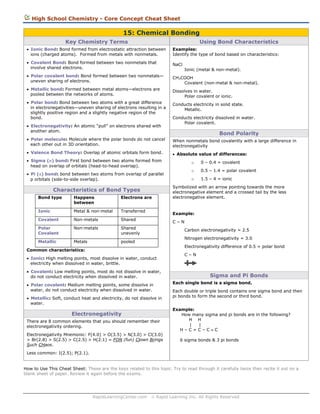
Chemical bonding cheat sheet
- 1. High School Chemistry - Core Concept Cheat Sheet 15: Chemical Bonding Key Chemistry Terms Using Bond Characteristics Ionic Bond: Bond formed from electrostatic attraction between ions (charged atoms). Formed from metals with nonmetals. Examples: Identify the type of bond based on characteristics: Covalent Bond: Bond formed between two nonmetals that involve shared electrons. NaCl Polar covalent bond: Bond formed between two nonmetals— uneven sharing of electrons. CH3COOH Covalent (non-metal & non-metal). Metallic bond: Formed between metal atoms—electrons are pooled between the networks of atoms. Dissolves in water. Polar covalent or ionic. Polar bond: Bond between two atoms with a great difference in electronegativities—uneven sharing of electrons resulting in a slightly positive region and a slightly negative region of the bond. Conducts electricity in solid state. Metallic. Electronegativity: An atomic “pull” on electrons shared with another atom. Ionic (metal & non-metal). Conducts electricity dissolved in water. Polar covalent. Bond Polarity Polar molecule: Molecule where the polar bonds do not cancel each other out in 3D orientation. When nonmetals bond covalently with a large difference in electronegativity Valence Bond Theory: Overlap of atomic orbitals form bond. Absolute value of differences: Sigma () bond: First bond between two atoms formed from head on overlap of orbitals (head-to-head overlap). o o Characteristics of Bond Types Bond type Happens between Electrons are Ionic Metal & non-metal Transferred Covalent Non-metals Shared Polar Covalent Non-metals Shared unevenly Metallic Metals pooled 0.5 – 1.4 = polar covalent o Pi () bond: bond between two atoms from overlap of parallel p orbitals (side-to-side overlap). 0 – 0.4 = covalent 1.5 – 4 = ionic Symbolized with an arrow pointing towards the more electronegative element and a crossed tail by the less electronegative element. Example: C–N Carbon electronegativity = 2.5 Nitrogen electronegativity = 3.0 Electronegativity difference of 0.5 = polar bond Common characteristics: Ionic: High melting points, most dissolve in water, conduct electricity when dissolved in water, brittle. Covalent: Low melting points, most do not dissolve in water, do not conduct electricity when dissolved in water. Polar covalent: Medium melting points, some dissolve in water, do not conduct electricity when dissolved in water. Metallic: Soft, conduct heat and electricity, do not dissolve in water. Electronegativity There are 8 common elements that you should remember their electronegativity ordering. Electronegativity Mnemonic: F(4.0) > O(3.5) > N(3.0) > Cl(3.0) > Br(2.8) > S(2.5) > C(2.5) > H(2.1) = FON (fun) Clown Brings Such CHaos. C–N Sigma and Pi Bonds Each single bond is a sigma bond. Each double or triple bond contains one sigma bond and then pi bonds to form the second or third bond. Example: How many sigma and pi bonds are in the following? H H | | H–C=C–CC 6 sigma bonds & 3 pi bonds Less common: I(2.5); P(2.1). How to Use This Cheat Sheet: These are the keys related to this topic. Try to read through it carefully twice then recite it out on a blank sheet of paper. Review it again before the exams. RapidLearningCenter.com Rapid Learning Inc. All Rights Reserved
